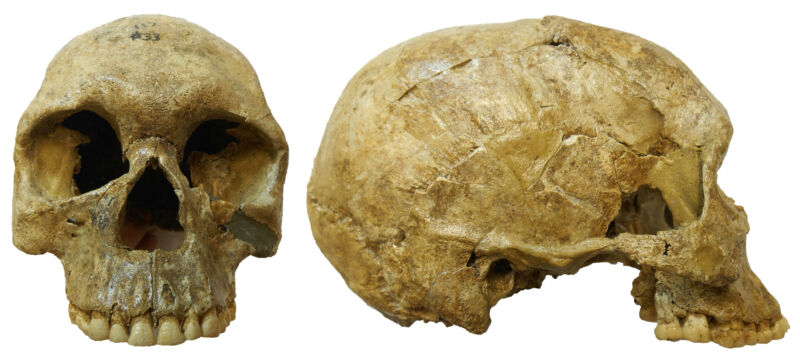When archaeologists in the 1960s unearthed a 13,400-year-old cemetery at Jebel Sahaba in Sudan, it looked like they’d stumbled across the aftermath of a large-scale battle fought during the Pleistocene. At least half the people buried at the site, which straddles the banks of the Upper Nile, bore the marks of violence: broken skulls, arrow and spear tracks gouged in bones, and stone projectiles still embedded in their bodies.
The site now lies at the bottom of the human-made Lake Nasser, created by the construction of the Aswan High Dam in the 1960s. But the remains now reside in the British Museum’s collection (for better or worse), and anthropologists Isabelle Crevecoeur of the University of Bordeaux and Daniel Antoine of the British Museum recently re-examined the skeletons. With more modern microscope technology, the anthropologists noticed some skeletal trauma that the original archaeologists had missed. It turned out that about two thirds of the population of the ancient cemetery had bones damaged by either blunt-force trauma or—most often—by projectiles like spears and arrows. That included three out of four adults and roughly half the children.
Since the 1960s, archaeologists have thought of Jebel Sahaba as the earliest example of large-scale warfare between groups of people. But despite all the evidence of violence, the bones of the 13,000-year-old dead don’t actually seem to tell the story of a pitched battle with massive casualties. Instead, it looks like people along the Upper Nile Valley at the end of the Pleistocene lived with the constant threat of smaller-scale fighting, which affected men, women, and children alike. If you’re a gamer, think of it as living in a PvP zone in the midst of an environmental crisis.
Broken bones and embedded arrowheads
The people who lived on the floodplain of the Upper Nile as the last Ice Age drew to a close left few traces behind, but it’s enough to tell us that they made their living by hunting, fishing, and gathering. And archaeologists who study the area have noticed that each small group seemed to have its own unique style of tools and weapons, “believed to represent a cultural tradition that reflects group identity.” At least some of those groups had apparently started to spend more time in one location, because they spent centuries burying their dead in large graveyards like Jebel Sahaba.
Those trademark sets of stone tool technology are actually the first clue that life around Jebel Sahaba was marked by fighting between rival groups. The stone tools and flakes archaeologists found scattered on the surface of the site weren’t the same style as the projectile points they found in the graves, embedded in bones or lying in spaces once filled by soft tissue. And while artifacts left behind on the surface included a mix of weapons and everyday tools, the graves contained only projectile points and fragments thereof—and many of them had been broken or cracked by the force of their impact with human bodies.
On the other hand, the occupants of Jebel Sahaba aren’t what you’d expect from a battlefield cemetery. Combat tends to involve young men more than any other group, so a cemetery containing the dead from a single battle should contain more young men and fewer children, elderly people, and women. But at Jebel Sahaba, the demographics look like a cross-section of a hunter-gatherer community, and no one seems to have been spared the trauma of violence. Women’s skeletons have broken bones and projectile wounds just as often as men’s skeletons, and at least half the children buried at Jebel Sahaba also show signs of having been shot or bludgeoned.
So what happened here?
Climate change and conflict
Around 14,000 years ago, Lake Victoria, in modern Tanzania and Uganda, overflowed and sent the White Nile—one of two rivers that merge to form the Nile—flowing northward across northeast Africa. That’s when the Nile’s trademark pattern of seasonal flooding started in earnest. At the same time, however, conditions in the Nile Valley turned hyper-arid. Facing long term drought punctuated by severe floods, people who made their living off the land probably found themselves scrambling to find scarce resources amid a suddenly harsh and unpredictable environment.
"Pressure in terms of access to resources is one of the main reasons for conflict in the past and the present," Crevecoeur told Ars in an email.
At the same time, different groups of people living in the region clearly had their own strong sense of identity; that’s the conclusion archaeologists draw based on the different styles of stone tool tech each group developed. It also seems, based on large cemeteries like Jebel Sahaba, that at least some of these groups also had a sense of territory, which may have seemed more vital as the environment changed around them. With all of those ingredients in place, conflict over space and resources seems, in hindsight, inevitable.
Then again, it’s important to remember how much the archaeological evidence can’t tell us about people’s motivations, beliefs, and feelings. "Cultural/behavioral reasons that are inaccessible to us may have been stronger motives," Crevecoeur told Ars. "What is certain is that violent acts are recorded [for] hundreds of thousands of years, but their motives are probably as complex and varied as we can imagine."



3175x175(CURRENT).thumb.jpg.b05acc060982b36f5891ba728e6d953c.jpg)


Recommended Comments
There are no comments to display.
Join the conversation
You can post now and register later. If you have an account, sign in now to post with your account.
Note: Your post will require moderator approval before it will be visible.